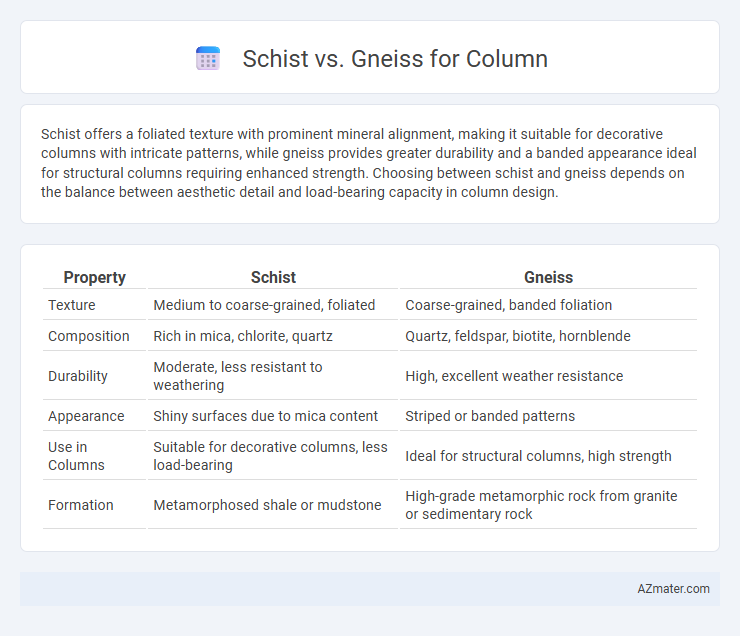Schist offers a foliated texture with prominent mineral alignment, making it suitable for decorative columns with intricate patterns, while gneiss provides greater durability and a banded appearance ideal for structural columns requiring enhanced strength. Choosing between schist and gneiss depends on the balance between aesthetic detail and load-bearing capacity in column design.
Table of Comparison
| Property | Schist | Gneiss |
|---|---|---|
| Texture | Medium to coarse-grained, foliated | Coarse-grained, banded foliation |
| Composition | Rich in mica, chlorite, quartz | Quartz, feldspar, biotite, hornblende |
| Durability | Moderate, less resistant to weathering | High, excellent weather resistance |
| Appearance | Shiny surfaces due to mica content | Striped or banded patterns |
| Use in Columns | Suitable for decorative columns, less load-bearing | Ideal for structural columns, high strength |
| Formation | Metamorphosed shale or mudstone | High-grade metamorphic rock from granite or sedimentary rock |
Introduction to Schist and Gneiss
Schist and gneiss are both metamorphic rocks formed under intense heat and pressure, but they differ in texture and mineral composition. Schist is characterized by its foliated structure with visible mineral grains like mica, giving it a shiny appearance. Gneiss exhibits a banded or layered appearance due to the segregation of mineral types, typically quartz, feldspar, and biotite, reflecting higher-grade metamorphic conditions.
Geological Formation of Schist and Gneiss
Schist forms through medium-grade metamorphism where intense heat and pressure recrystallize clay-rich sedimentary rocks, producing foliated textures dominated by mica minerals. Gneiss originates from high-grade metamorphism, involving greater temperature and pressure conditions that realign minerals into distinct, alternating light and dark bands of quartz, feldspar, and biotite. The geological formation of Schist emphasizes mineral alignment in platy grains, while Gneiss exhibits pronounced banding due to mineral segregation during regional metamorphism.
Physical Appearance and Texture Comparison
Schist exhibits a foliated texture with visible mica flakes giving it a shiny, flaky appearance, often appearing silver or gray in color due to its high mica content. Gneiss has a banded or striped appearance with alternating layers of light and dark minerals, featuring a coarser grain and a more rigid, layered structure. While schist feels more flaky and soft, gneiss is typically harder and more durable, making it suitable for columns requiring structural strength and decorative banding.
Structural Strength: Schist vs Gneiss
Gneiss exhibits superior structural strength compared to schist due to its tightly interlocking mineral grains and foliation, making it more resistant to weathering and mechanical stress. Schist, characterized by its pronounced foliation and platy minerals, tends to have weaker shear strength and higher susceptibility to cleavage planes, reducing its load-bearing capacity. For columns requiring maximum durability and stability, gneiss is typically preferred over schist due to its enhanced compressive strength and structural integrity.
Weathering Resistance and Durability
Gneiss exhibits superior weathering resistance compared to schist due to its coarse-grained, interlocking mineral structure, which enhances durability under environmental stress. Schist's foliated texture makes it more prone to splitting and erosion when exposed to moisture and temperature fluctuations. For column construction, gneiss provides greater long-term stability and strength, making it the preferred material in demanding weather conditions.
Workability and Fabrication for Columns
Schist offers easier workability for columns due to its foliated texture, allowing smoother cutting and shaping with less effort compared to gneiss. Gneiss, characterized by its banded structure and higher density, provides greater durability but requires more advanced tools for precise fabrication. For column construction, choosing schist results in faster installation with moderate strength, while gneiss demands skilled labor to achieve intricate designs and long-lasting performance.
Aesthetic Appeal for Architectural Columns
Schist offers a unique aesthetic appeal for architectural columns with its foliated texture and sparkling mica crystals that create a shimmering effect in natural light. Gneiss features distinct banding and a coarse-grained structure, providing a bold, layered appearance ideal for columns that demand visual impact and sophistication. The choice between schist and gneiss depends on desired texture and finish, with schist highlighting subtle elegance and gneiss delivering dramatic contrast.
Cost and Availability in the Market
Schist and gneiss vary significantly in cost and market availability, with schist generally being more affordable due to its wider distribution and simpler extraction methods. Gneiss, known for its durability and aesthetic appeal, commands higher prices and is less abundantly available, impacting project budgets and procurement timelines. Market demand also affects supply chains, where gneiss's premium qualities often limit availability compared to the more common schist.
Case Studies: Columns Using Schist vs Gneiss
Case studies on columns using schist versus gneiss reveal distinct structural and aesthetic outcomes due to their mineral compositions and durability. Schist columns, favored for their foliated texture and ease of shaping, are prominent in decorative architectural applications, yet they demonstrate lower resistance to weathering compared to gneiss. Columns constructed from gneiss, characterized by its coarse-grained texture and high compressive strength, are commonly employed in load-bearing structures, showcasing superior longevity in both historic temples and modern infrastructure projects.
Final Recommendations for Choosing Column Material
Gneiss is recommended over schist for column material due to its higher strength, durability, and resistance to weathering, making it suitable for structural and load-bearing applications. Schist, with its foliated texture, is more prone to splitting and deformation under stress, limiting its use to decorative or non-structural elements. For long-lasting columns requiring stability and support, gneiss offers superior performance and longevity.

Infographic: Schist vs Gneiss for Column
 azmater.com
azmater.com